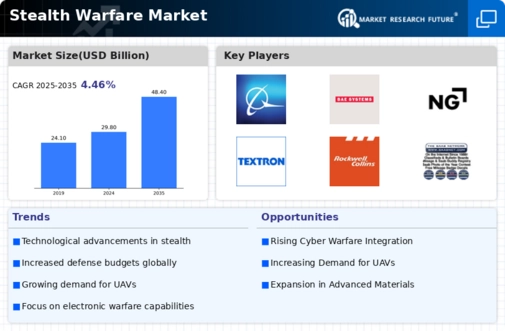Market Trends
Key Emerging Trends in the Stealth Warfare Market
The stealth warfare market is experiencing significant trends that mirror the evolution of military strategies and technologies in the contemporary security landscape. One prominent trend is the increasing emphasis on developing and deploying stealth technologies across various defense platforms. As nations seek to enhance their strategic capabilities, there is a growing focus on creating stealthy aircraft, ground vehicles, naval vessels, and even soldiers to operate in contested environments with reduced susceptibility to detection by enemy sensors.
The report's nation section also includes specific market-impacting variables and regulatory changes that affect the market's present and potential future trends. The market scenario for each country is predicted using a variety of data points, including case studies, technical trends, porter's five forces analysis, and upstream and downstream value chain analysis. While providing a forecast analysis of the country data, other factors taken into account are the availability and presence of global brands, the difficulties these brands experience as a result of intense or little competition from local and domestic brands, the impact of domestic tariffs, and trade routes.
A key driver of this trend is the growing importance of anti-access/area denial (A2/AD) strategies, where nations aim to limit the adversary's ability to operate freely within a particular area. Stealth technologies play a crucial role in countering A2/AD challenges by allowing military assets to operate covertly and penetrate enemy defenses, providing a significant tactical advantage. This has led to an increased investment in research and development to advance stealth capabilities across a broad spectrum of defense applications.
Moreover, the integration of artificial intelligence (AI) and advanced sensor technologies is shaping the evolution of stealth warfare. AI-enabled systems enhance the effectiveness of stealth platforms by improving autonomous decision-making, adaptive tactics, and real-time situational awareness. Stealthy unmanned systems, equipped with AI, contribute to the development of intelligent and agile warfare strategies, allowing military forces to operate with greater precision and efficiency in complex and dynamic environments.
The naval domain is witnessing a notable trend in the adoption of stealth technologies for submarines and surface vessels. Stealthy submarines, equipped with advanced acoustic and magnetic signature reduction technologies, enhance their ability to operate undetected in strategic areas. Surface vessels are also incorporating stealth features to reduce their radar cross-section and infrared signatures, making them less vulnerable to enemy detection and targeting.
Furthermore, advancements in electronic warfare (EW) are influencing the stealth warfare market. Electronic countermeasures and electronic support measures are becoming integral components of stealth strategies, enabling the disruption of enemy sensors and communication systems. The integration of EW capabilities enhances the survivability and effectiveness of stealth platforms in contested environments, contributing to the overall success of military operations.
International collaborations and joint development programs are emerging as a significant trend in the stealth warfare market. Many nations recognize the complexity and cost associated with developing and maintaining cutting-edge stealth technologies. Collaborative efforts allow nations to pool resources, share expertise, and jointly develop advanced stealth platforms that meet shared defense objectives. These partnerships also foster interoperability among allied forces, enhancing the collective strength of military coalitions.
The COVID-19 pandemic has impacted the global economy, including defense budgets and production timelines. However, the pandemic has underscored the importance of resilient and adaptable defense capabilities, driving a renewed focus on stealth technologies as nations reevaluate their strategic priorities and defense postures in the face of evolving security challenges.

















Leave a Comment